
Bikes of the World
The epitome of transportation efficiency
O
ne of an ever-diminishing number of great experiences available today is to travel by bicycle in a part of the World where that beautiful machine is one of the dominant forms of transport. Those places are, unfortunately, decreasing in numbers as well, at least for the time being. I knew that I would find some of them along the Tour route, but I did not expect to see the wide variety of makes and styles of bikes still in use today. From my earlier international tours, I knew that I would see a number of hand-me-down bikes from the "First World" rolling down the highways of the Worlds of higher numbers. However, I also expected that most of the bikes I would encounter would be similar to those shown in the image below, basic, low-cost, quasi-mountain bikes, mass-produced in East Asian factories. I was surprised to learn that there is, in fact, still a level of distinctiveness in the bikes of the World. Had I known that would be the situation, I would have paid more attention to the types that are out there, in order to find out what made them unique. In any case, here are some of the more distinctive examples I did manage to observe.
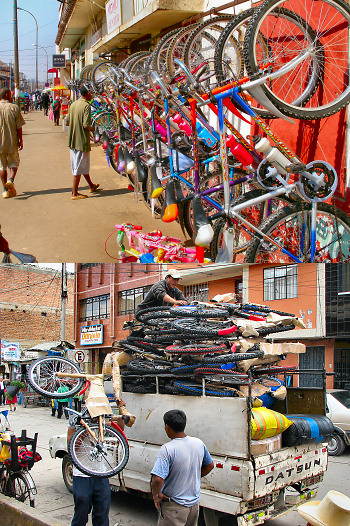
New bikes for sale in Antsirabe, Madagascar and Huaraz, Peru
A Bereft Continent
One of the reasons that my attention towards bikes faltered was that Australia, which occupied almost all of Stage 1, is a country remarkably lacking in indigenous cyclists. To be sure, the relatively densely populated eastern coastal regions have their share of mainstream cyclists, who ride the same bikes one would find in North America or Europe. However, even there, many of the cyclists I encountered were international tourists. Once I ventured into the Outback for good, other bike tourists were pretty much all I saw. I certainly enjoyed seeing their bikes, but most were not all that different from mine, apart from the occasional recumbent. The only really distinctive bicycle I saw in that country was part of the unusual outdoor art piece shown below. It did, however, reinforce the notion for me, that the correct term for the conveyance in those parts is Push Bike
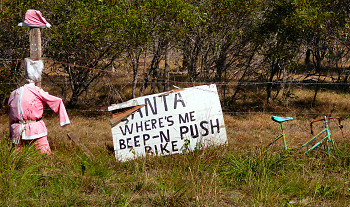
A classic piece of rural art in Queensland, Australia
A Beautiful Commute
As someone who journeyed to his (former) employment by bicycle just about every day, whenever I arrived at a place during the Tour where most of the local population did as well, I felt as if I had reached a state of cycling nirvana. If that included young people, out enjoying the fitness and camaraderie of bicycle travel while going to and from school, well, that was even more appealing. Stages 2 and 3 were the times when I was fortunate enough to have these experiences most often. It does not matter if one speaks the same language as those around you in those situations, as the language of the bicycle is universal.
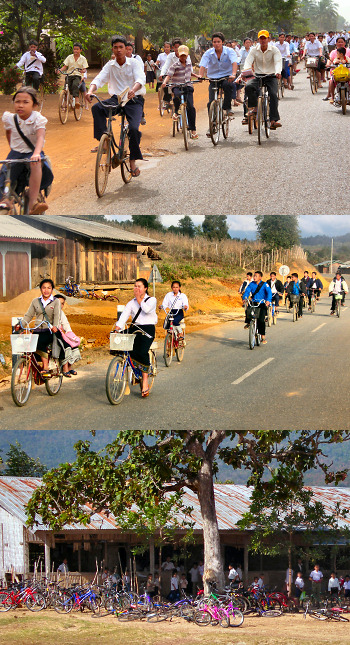
Students returning home from school in Kompong Thnor, Cambodia (Top);
and near Phonvason, Laos (Middle);
Bikes parked at a rural school in Laos (Bottom)
It is also a great thing to see a group of bikes left together by the side of the road, while their owners go about their daily jobs. The most impressive examples of that were the Bolivian road maintenance crews who must have ridden for quite a distance across the windy, cold Altiplano in order to reach the areas which needed service.
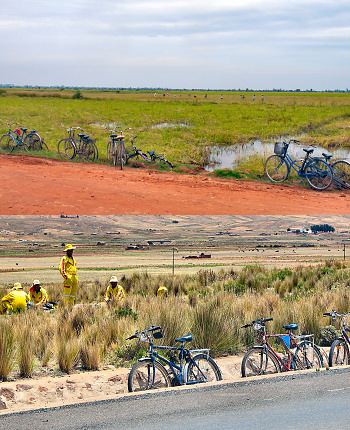
Bikes brought these workers to a rice paddy in Cambodia (Top);
and a road maintenence crew to their job on the Altiplano of Bolivia
Somewhat surprisingly, even the most space-saving form of transport, the bike, when used in large enough numbers, can create a jammed-up situation. India was a country where that occurred now and then, such as this example, in Bodh Gaya.
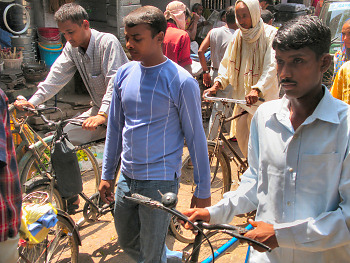
A street crowded with bikes in Bodh Gaya, India
Multi-Person Rides
Though they usually require a third wheel, bikes that carry extra passengers are still a part of the family. They serve an incredibly usefully purpose in crowded cities, and do so quietly, and cleanly. Their use is common in many regions, though often their distribution is somewhat spotty, and most of the ones I saw were in Asia. I have heard reports that cities such as New York, have seen increasing numbers of these vehicles, an example of the many things we can yet learn from the so-called undeveloped world. I did notice, however, that some of the pedicabs in use, even in this age, could greatly benefit from some very basic gearing improvements.
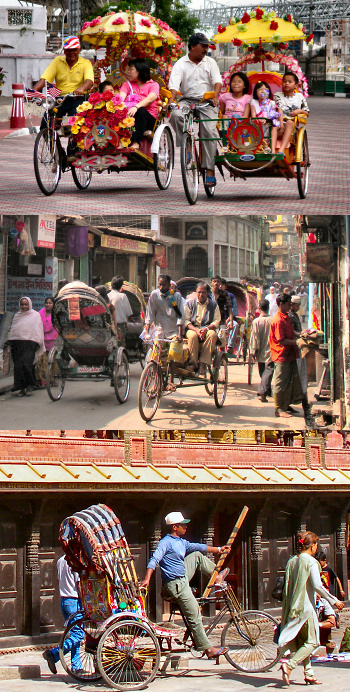
Pedicabs in Melaka, Malaysia (Top), Dhaka, Bangladesh (Middle);
and Kathmandu (Bottom)
The World Needs Cargo
Personal transportation is not the only use for bicycles, of course. In a world of cities and towns, material goods must be moved to the people that want them, and a good bike can do that job quite well. I can certainly appreciate the intricacies of carrying extra weight on a bike, after hauling an additional 25 kg around the World, and so I noted with interest the creative ways that people in disparate places accomplished such tasks. Again, this often requires the use of our working-class cousin, the trike. Though, sometimes two wheels are quite adequate, as shown by the basketmen below.
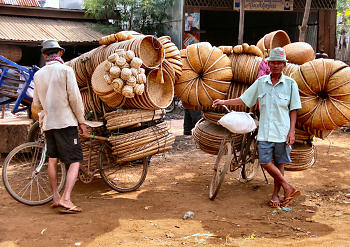
Large loads of Baskets on Bikes near Phnom Phen, Cambodia
The next five examples were all seen in Bangladesh, the epicenter for interesting human-powered contraptions.
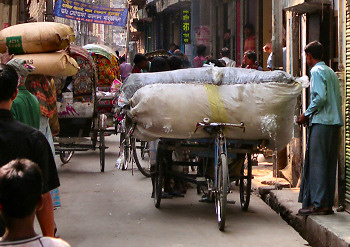
A wide load on a bike in Dhaka
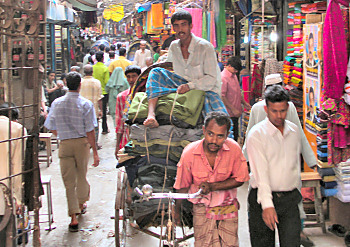
Too much cargo? Just hop on top
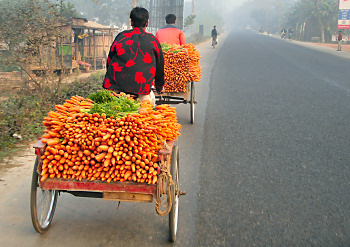
Mmmmm.... Carrots
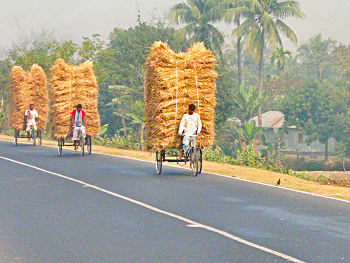
A Caravan of Straw on cargo bikes
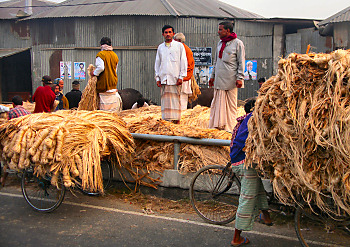
Bikes pull up to a Jute distributor, then roll out with a big load
In the driest parts of my route, I frequently carried what I thought to be an extraordinary amount of water, sometimes in the vicinity of 15 liters. However, I never came close to the load that these fellows in Rwanda were hauling.
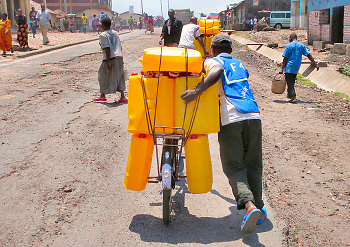
Water being carried on bikes in Gisyeni, Rwanda
And when you need to move some delicate fruit, like these baskets full of tomatoes, nothing can get the job done better than a sturdy bike.
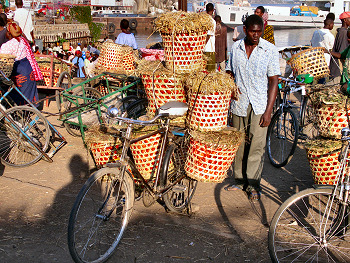
A man loads up baskets of tomatoes at Mwanza port in Tanzania
In parts of Latin America, mainly the Andean region, Central America, and Mexico, these interesting front-loading multi-purpose bikes were a common sight. They can be used to carry either passengers or cargo, and employ a unique center-pivoting frame design. That makes them a little more maneuverable than most of their cargo-carrying relatives, though they are certainly not the speediest things on wheels.
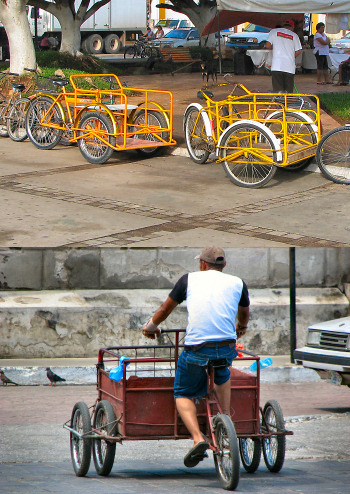
Latin American-style cargo bikes in Izamal, Mexico (Top);
and a five-wheeled version in Leon, Nicaragua
It may be somewhat hard to see in the photo below, but the loads that these fellows in Burundi are moving—bricks.
Bricks! I have carried some heavy loads in my time, especially back at home with my BoB trailer, but I haven't even come close to this.
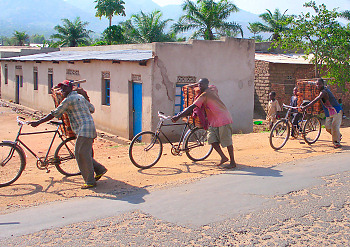
Yes, these bikes are moving bricks. South of Bujumbura, Burundi
Nothing Lasts Forever
Of course, with all that riding and cargo carrying, even the sturdiest bike needs to be repaired now and then. Fortunately, in parts of the World where bikes are common, one is never very far from a place that can fix or re-supply a bike. On the other hand, many such places employ time-honored methods such as replacing a spoke with coat-hanger wire, or making odd parts fit by whacking them with a big hammer. So, touring cyclists who are not self-sufficient should exercise appropriate caution when seeking such assistance.
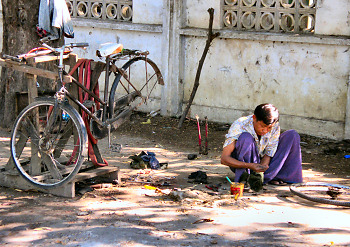
A man repairs bikes in Mandalay, Myanmar
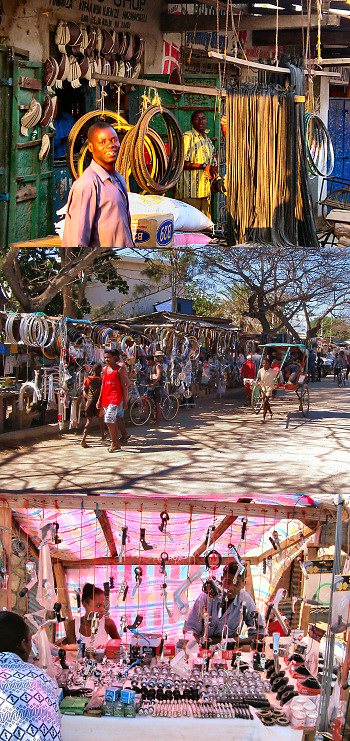
Bike parts stands in Tanzania (Top) and Madagascar
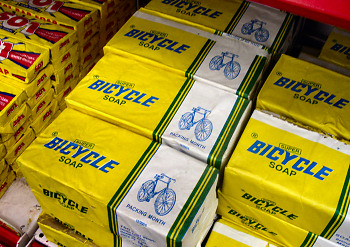
After a messy bike repair, clean up with some Super Bicycle Soap!
A Matter of Style
As I have mentioned already, I did not expect to see the continued existence of indigenous bicycle industries on other continents. However, some regional industries have withstood the onslaught of the mass-produced-bike juggernaut. Probably the largest of these are comprised of the Indian bicycle companies, the largest of which are Hero, reported to be the largest bicycle producer in the World, and Atlas. Most of the models seen on the region's roads are definite classics, with sprung saddles, steel rims, full fenders, reinforced forks, and rod-articulated brakes (at least when the brakes are still present.) Both of these companies produce what most people would consider to be "modern" bikes, with all of the latest-styled components. However it is the "Roadster" models, like the one in the image below, that dominate the stores and the roads. Tradition dies hard, apparently. Such bikes are also the most common type seen in the neighboring countries of South Asia.
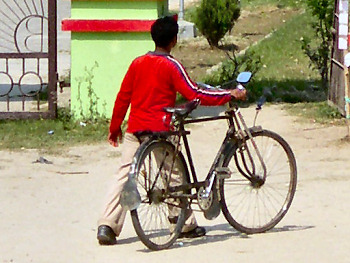
A Roadster bike in India
I was a little more surprised to see a large number of somewhat similar bikes in Argentina. Those were more like what would be termed "Beach Cruisers" in the USA, and are used in small cities and towns in the flat regions of the country, regardless of whether there is a beach nearby, or not. Argentina is a very up-to-date country in many respects, but their bicycle industry is not really one of those. It is not that there is anything wrong with that type of bike, but good luck to any international tourist who needs to find replacement bike parts in that part of the world.
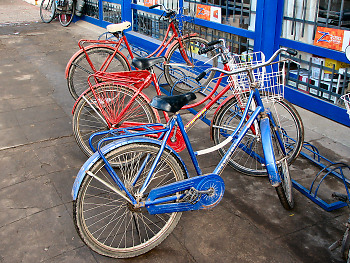
Cruiser bikes are common in Argentina
Brazil may have a few more mainstream bikes around, but there are also plenty of local favorites like the one shown below. The stylish, but ultimately useless, circular frame reinforcement is a nice touch.
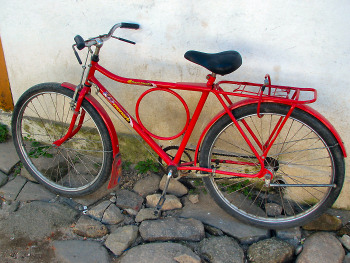
A bike in Paraty, Brazil
This nice bike, seen in Mexico, was one of my favorites. I like its classic "drooping" handlebars which are reminiscent of an early 20th-century French bike poster I have hanging in my garage.
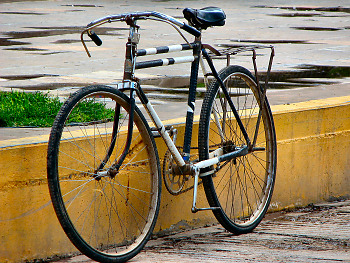
A classic bike in Villa Gonalez Ortiz, Mexico
Mine is a Bike of the World
Though it may be comprised of different parts, and partially made from different materials, I think that my bike, with its gutsy performance during the Tour, fits right in with all of its cousins that I saw along the way. These last two images attest to its worldly ways.
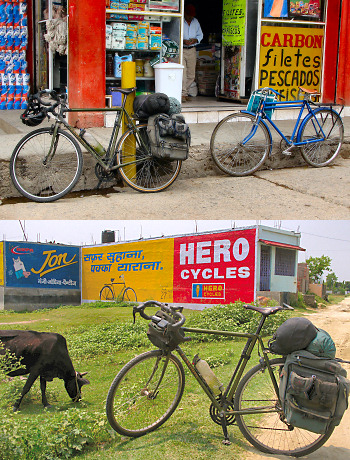
My Hero. In Mexico (Top), and India
Previous | Next
Main Index | Pre-Tour Index
Post-Tour Index | Articles Index
Slideshows
Main Index Pre-Tour Post-Tour Articles Previous Next |
The Perplexing World of Bicycle Tires
Bicycle tires and wheels have been produced in an amazing variety of sizes since the origins of the machines in the 19th century. Today, in the western world, cyclists have only to choose between the two dominant sizes; ISO 559, the so-called "26-inch" wheels found on mountain bikes, and some other types; and ISO 622, also known as "700c" or, confusingly, "28-inch", used on road bikes and "hybrid" bikes. Once the choice of wheel is made, of course, the rider is stuck with the need to use the corresponding tire size, as even small differences are not compatible. Many global tourists go with ISO 559, as it is the only size for which tires and rims can be located with certainty in nearly 100% of the World's bike shops. Larger riders, like me, or those that simply prefer the feel of larger wheels, also like me, may choose, as I did, to go with 700c.
I purchased a cache of suitable tires before the Tour began, and hoped that they would be enough for the entire Tour. However, due to certain defects and damages (described in more detail on the Gear Reviews page,) I needed to locate replacements in several locations along the way. That proved to be a challenge, because the most common tire size in the World as a whole is still the just-slightly-larger ISO 635, also commonly referred to as "28-inch" and, less frequently, "700b". These are found on a large majority of bikes in Asia, Africa, and parts of South America. Though I should have known better, I noticed a tire labeled "28-inch" in Asia, and purchased it before learning, once and for all, that there is more than one "28-inch" and that the extra 13 mm of diameter really does matter. From then on, I was more careful and, occasionally with great difficulty, I located 700c tires in; Phnom Phen, Cambodia (where I believe I bought the only one available in the whole country); Lilongwe, Malawi; Polokwane, South Africa (where the selection was very good); Viedma, Argentina (where I was lucky to find any at all); Punta Arenas, Chile; and Merida and Chihuahua, Mexico. The width and durability of these tires was rarely as good as I would have liked, however. Next time I will be more certain of the tires I buy in advance.
What was even a bigger surprise to me was the predominance of the old-fashioned style "Woods Valves" which are, once again, the most common type seen in Asia, Africa, and Argentina. That peculiar valve seems to be sort of a holdover from the early days of cycling, but since there is such a huge installed base of that type, not to mention their corresponding pumps (with clamp-type heads,) in those parts of the World, it seems that they will be with us for quite a while. Fortunately, a presta-valve pump will work, to a degree, with Woods valves, though the pump has a tendency to pop off while it is being used in such cases. The annoying thing about a Woods valve is that the valve stem must be disassembled in order to mount the tube in the rims, which may be fine in a home or a typical shop, but can be a big pain on a windy, or sandy roadside.
There is much more that could be said on these topics, but instead of doing so myself, I will refer readers to the much more informative pages (tires and tire sizes) by the late, great Sheldon Brown, because, As Always, Sheldon Had The Answer.